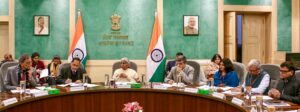Budget 2025: Government Unveils Ambitious Plan to Boost Economy and Address Rising Costs
January 31, 2025 – In a bold move aimed at addressing mounting economic pressures, the government has unveiled its highly anticipated Budget 2025, which promises significant investments in key sectors to foster economic growth, tackle rising living costs, and create new job opportunities. The plan, presented by Finance Minister Emily Wright, is being hailed as one of the most comprehensive fiscal strategies in recent years.

The government’s primary focus is to reduce the financial strain on citizens, particularly amid skyrocketing prices for everyday goods and services. At the same time, it seeks to stimulate economic growth and ensure that the country remains competitive in an increasingly globalized world.
Key Highlights of the Budget:
- Cost-of-Living Relief: Acknowledging the burden of inflation on households, Budget 2025 includes measures designed to reduce living costs. A notable provision is the introduction of direct financial support to lower-income households, including a one-time payment of $1,000 for families with children under the age of 18. This will help to offset rising costs in essentials such as food, energy, and healthcare.
Additionally, the government has pledged to freeze taxes on essential goods, including fuel and basic groceries, for the next 12 months, providing immediate relief for millions of consumers. The aim is to alleviate the effects of inflation without compromising on the government’s ability to fund long-term investments.
- Infrastructure Investments: A cornerstone of the budget is a $40 billion infrastructure package that will focus on upgrading transportation networks, improving energy efficiency, and investing in digital infrastructure. This package is expected to generate thousands of new jobs, particularly in construction, technology, and renewable energy sectors.
The government is particularly focused on modernizing public transport systems, including a proposed high-speed rail project that will link major cities across the country, reducing travel times and boosting regional economic integration. Renewable energy initiatives are also at the forefront, with plans to expand wind and solar energy projects to reduce reliance on fossil fuels.
- Tax Reforms to Support Businesses: In an effort to encourage innovation and entrepreneurship, the budget includes several tax reforms aimed at easing the burden on businesses, particularly small and medium-sized enterprises (SMEs). The corporate tax rate will be reduced by 5%, while tax incentives for research and development (R&D) investments will be increased.
“Our vision is to create a thriving business ecosystem where entrepreneurs can flourish and create jobs,” Minister Wright said. “These tax cuts and incentives will give businesses the breathing room they need to innovate, grow, and hire more workers.”
- Education and Workforce Development: Recognizing the need for a skilled workforce in the evolving economy, the budget allocates $15 billion to education and workforce development programs. This includes funding for vocational training and apprenticeships, aimed at preparing workers for jobs in emerging sectors such as technology, renewable energy, and healthcare.
Additionally, the government is setting aside funds to improve access to higher education by increasing grants for students from lower-income backgrounds and expanding access to affordable online learning platforms.
- Healthcare Investment: The healthcare sector will see a significant boost with an additional $8 billion in funding, primarily aimed at improving access to mental health services and reducing waiting times for essential medical treatments. The government also plans to expand public health insurance coverage for chronic conditions, which is expected to reduce the financial burden on families with long-term medical needs.
Economic Outlook and Challenges: While the Budget 2025 package has been broadly welcomed, economists have raised concerns about the long-term fiscal impact of such extensive spending. The government plans to fund these initiatives through a mix of increased borrowing and higher taxes on luxury goods and high-income earners.
Opposition parties have expressed skepticism, particularly regarding the sustainability of the budget’s proposed investments. “We support efforts to ease the cost of living and stimulate growth, but we need to ensure that these measures do not jeopardize our financial stability in the years to come,” said the opposition leader, John Marshall.
Conclusion: Overall, Budget 2025 represents a bold vision for the country’s economic future, combining immediate relief for citizens with strategic investments in infrastructure, education, and healthcare. While challenges remain, the government’s plan aims to balance short-term support with long-term economic growth, hoping to steer the nation through uncertain times and build a more prosperous future for all.




